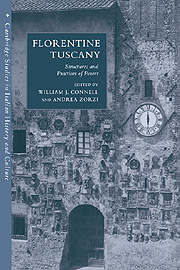Book contents
- Frontmatter
- Contents
- List of figures
- List of tables
- List of abbreviations of archival sources
- Introduction
- 1 The ‘material constitution’ of the Florentine dominion
- 2 The language of empire
- 3 Constitutional ambitions, legal realities and the Florentine state
- 4 Fiscality, politics and dominion in Florentine Tuscany at the end of the middle ages
- 5 Market structures
- 6 State-building, church reform and the politics of legitimacy in Florence, 1375–1460
- 7 The humanist citizen as provincial governor
- 8 Territorial offices and officeholders
- 9 Demography and the politics of fiscality
- 10 Florentines and the communities of the territorial state
- 11 Patronage and its role in government: the Florentine patriciate and Volterra
- 12 San Miniato al Tedesco: the evolution of the political class
- 13 The social classes of Colle Valdelsa and the formation of the dominion (fourteenth–sixteenth centuries)
- 14 Arezzo, the Medici and the Florentine regime
- 15 Rubrics and requests: statutory division and supra-communal clientage in Pistoia
- 16 A comment
- Index
- CAMBRIDGE STUDIES IN ITALIAN HISTORY AND CULTURE
Introduction
Published online by Cambridge University Press: 16 September 2009
- Frontmatter
- Contents
- List of figures
- List of tables
- List of abbreviations of archival sources
- Introduction
- 1 The ‘material constitution’ of the Florentine dominion
- 2 The language of empire
- 3 Constitutional ambitions, legal realities and the Florentine state
- 4 Fiscality, politics and dominion in Florentine Tuscany at the end of the middle ages
- 5 Market structures
- 6 State-building, church reform and the politics of legitimacy in Florence, 1375–1460
- 7 The humanist citizen as provincial governor
- 8 Territorial offices and officeholders
- 9 Demography and the politics of fiscality
- 10 Florentines and the communities of the territorial state
- 11 Patronage and its role in government: the Florentine patriciate and Volterra
- 12 San Miniato al Tedesco: the evolution of the political class
- 13 The social classes of Colle Valdelsa and the formation of the dominion (fourteenth–sixteenth centuries)
- 14 Arezzo, the Medici and the Florentine regime
- 15 Rubrics and requests: statutory division and supra-communal clientage in Pistoia
- 16 A comment
- Index
- CAMBRIDGE STUDIES IN ITALIAN HISTORY AND CULTURE
Summary
In the century that followed the Black Death of 1348, the republic of Florence became the dominant power in Tuscany, absorbing within its dominion a large number of formerly independent communes and their rural territories, so that the area controlled by Florence nearly tripled in size. The plague itself seems to have contributed to Florentine expansion, for, although the disease roughly halved the population of all of the Tuscan urban centres, Florence, as the region's largest city, still commanded resources that permitted her to capitalise on the new weakness of her neighbours. Florentine growth was accomplished through a steady series of purchases, conquests and alliances (see Map on p. 3) and it was accompanied by important efforts to integrate newly acquired lands into the Florentine state. The century of dramatic territorial expansion had important and lasting consequences for the political and economic history of Florence and Tuscany. It also corresponded with the first flourishing of the cultural phenomenon we know as the Florentine Renaissance.
It used to be thought that the Renaissance was an affair strictly for cities. A distinguished scholarly tradition has long held that the distinctive urban society of late medieval Italy made possible the political and philosophical speculation of humanist scholars as well as the masterpieces of Renaissance artists.
- Type
- Chapter
- Information
- Florentine TuscanyStructures and Practices of Power, pp. 1 - 5Publisher: Cambridge University PressPrint publication year: 2000
- 11
- Cited by



